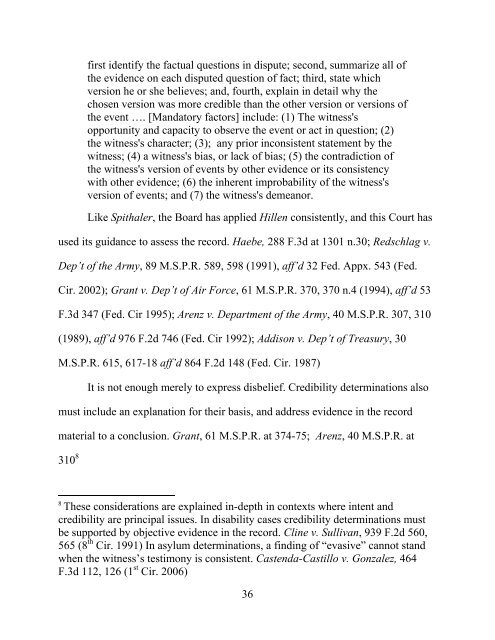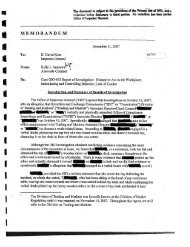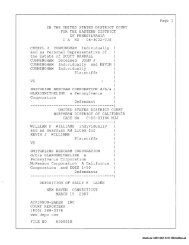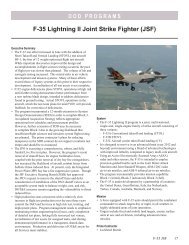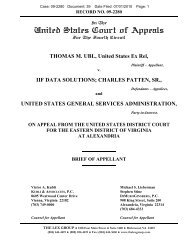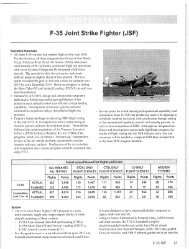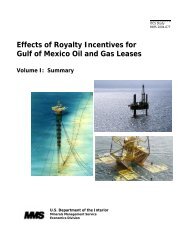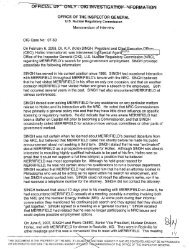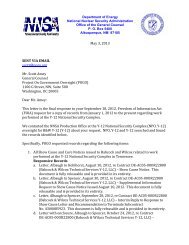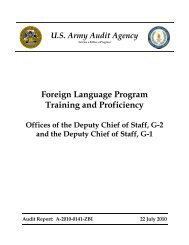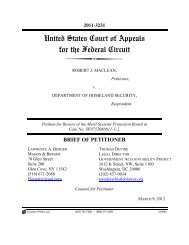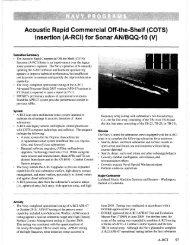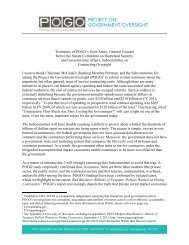United States Court of Appeals for the Federal Circuit
United States Court of Appeals for the Federal Circuit
United States Court of Appeals for the Federal Circuit
Create successful ePaper yourself
Turn your PDF publications into a flip-book with our unique Google optimized e-Paper software.
first identify <strong>the</strong> factual questions in dispute; second, summarize all <strong>of</strong><br />
<strong>the</strong> evidence on each disputed question <strong>of</strong> fact; third, state which<br />
version he or she believes; and, fourth, explain in detail why <strong>the</strong><br />
chosen version was more credible than <strong>the</strong> o<strong>the</strong>r version or versions <strong>of</strong><br />
<strong>the</strong> event …. [Mandatory factors] include: (1) The witness's<br />
opportunity and capacity to observe <strong>the</strong> event or act in question; (2)<br />
<strong>the</strong> witness's character; (3); any prior inconsistent statement by <strong>the</strong><br />
witness; (4) a witness's bias, or lack <strong>of</strong> bias; (5) <strong>the</strong> contradiction <strong>of</strong><br />
<strong>the</strong> witness's version <strong>of</strong> events by o<strong>the</strong>r evidence or its consistency<br />
with o<strong>the</strong>r evidence; (6) <strong>the</strong> inherent improbability <strong>of</strong> <strong>the</strong> witness's<br />
version <strong>of</strong> events; and (7) <strong>the</strong> witness's demeanor.<br />
Like Spithaler, <strong>the</strong> Board has applied Hillen consistently, and this <strong>Court</strong> has<br />
used its guidance to assess <strong>the</strong> record. Haebe, 288 F.3d at 1301 n.30; Redschlag v.<br />
Dep’t <strong>of</strong> <strong>the</strong> Army, 89 M.S.P.R. 589, 598 (1991), aff’d 32 Fed. Appx. 543 (Fed.<br />
Cir. 2002); Grant v. Dep’t <strong>of</strong> Air Force, 61 M.S.P.R. 370, 370 n.4 (1994), aff’d 53<br />
F.3d 347 (Fed. Cir 1995); Arenz v. Department <strong>of</strong> <strong>the</strong> Army, 40 M.S.P.R. 307, 310<br />
(1989), aff’d 976 F.2d 746 (Fed. Cir 1992); Addison v. Dep’t <strong>of</strong> Treasury, 30<br />
M.S.P.R. 615, 617-18 aff’d 864 F.2d 148 (Fed. Cir. 1987)<br />
It is not enough merely to express disbelief. Credibility determinations also<br />
must include an explanation <strong>for</strong> <strong>the</strong>ir basis, and address evidence in <strong>the</strong> record<br />
material to a conclusion. Grant, 61 M.S.P.R. at 374-75; Arenz, 40 M.S.P.R. at<br />
310 8<br />
8 These considerations are explained in-depth in contexts where intent and<br />
credibility are principal issues. In disability cases credibility determinations must<br />
be supported by objective evidence in <strong>the</strong> record. Cline v. Sullivan, 939 F.2d 560,<br />
565 (8 th Cir. 1991) In asylum determinations, a finding <strong>of</strong> “evasive” cannot stand<br />
when <strong>the</strong> witness’s testimony is consistent. Castenda-Castillo v. Gonzalez, 464<br />
F.3d 112, 126 (1 st Cir. 2006)<br />
36


